|
|
|
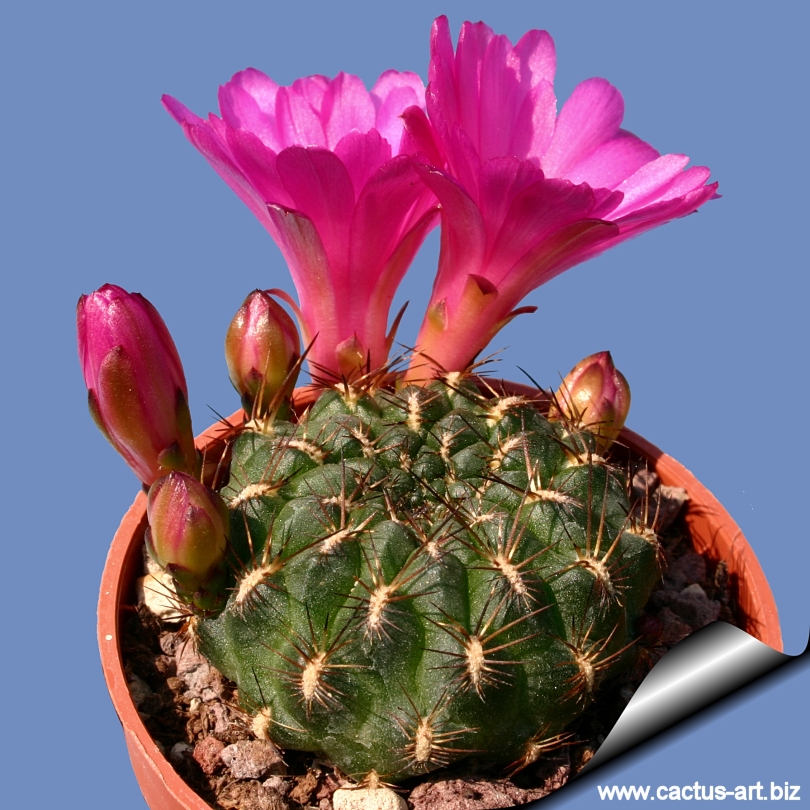
Sulcorebutia steinbachii
|
-
Description: It is a clumping plant
(rarely
solitary), readily forming, especially in cultivation,
clumps of many
heads.
Plants are often dimorphic: short spined juvenile forms transform at
maturity to strongly spined forms. Some of these juvenile forms,
however, may persist without transformation to the mature form.
Stem: 24-40 mm tall, up to 50 mm wide, flattened globose,
greysh-green to dark green sometime tinged red.
Ribs: Approx 13, spiralling,
poorly distinguished, forming oblong rhomboidal grooved
tubercles.
Areoles: Long
narrow
depressed
with short grey felt
(almost naked) 3 – 6 long,
1,5-2 mm large.
Radial spines: 9-12 (or more) about up to 20 mm long,
acicular,
addpressed against the
body, ±
pectinate to porrect,
white, yellow,
brown with darker tips or almost black, ± curved slow to develops,
frequently absent on new areoles at plant apex.
Central spines: None or usually 1 to 3, 10-30 mm long, only
slightly stouter of the same colour of the radials.
Flowers: Arising from
monoflorous areoles, in
lower lateral flower zone.
Rarely more than 3,5 cm long
and 4,5 in diameter, yellow, red, magenta or orange with white inner
petals.
Floral tube funnel-shaped, with broad naked scales.
Phenology:
Blossoming time: Late
spring.
Fruits:
Small papery olive
green to reddish brown at maturity.
Seeds:
Black.
|
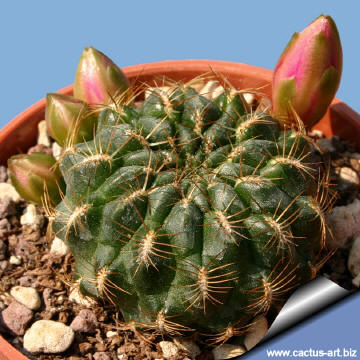 |
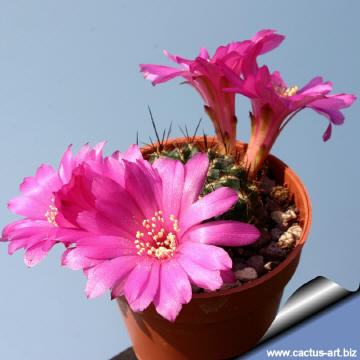 |
|
Floral tube
funnelform with greenish
to tan coloured
scales.
|
|
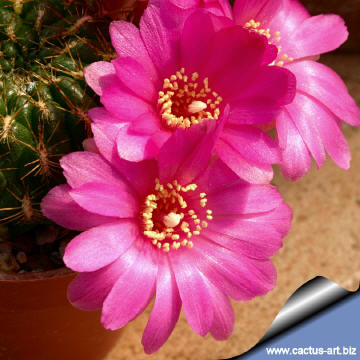 |
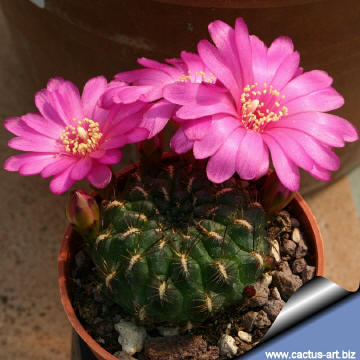 |
|


Advertising
|
|
|
|
|
Family:
Cactaceae (Cactus
Family)
Scientific Name:
Sulcorebutia steinbachii
Werderman 1931
Distribution:
North and east of Cochabamba in the Cordillera de Cochabamba, in
southern Bolivia.
Sulcorebutia is the type
species of the genus Sulcorebutia. The first plants were
collected near Colomi, along the route from Cochabamba to Chapare, by a
Herr Steinbach.
Habitat: Grows mainly on a flat,
dry, stony area along the banks of the Rio Lopez, just before the
moister zone of the tiraquensis populations. Altitude
Habitat:
Grows
mainly on high altitude, dry, stony habitats often on flats. Altitude
2950 – 3900 m.
Conservation status: Listed in
CITES Appendix II.
Cultivation:
S. polymorpha loves a very
permeable, coarse
mineral soil as well as to be strictly
kept dry throughout the
winter quiescent period since it is very
sensitive to any
moisture excesses, To prevent
rottenness it is also advisable to surround its
root neck by very rough
sand or
grit, this help a fast water
drainage and an appropriate
air circulation. Plants are quite
frost hardy -5 (-10)° C
Watering Needs:
Water
moderately in the
growing season, keep
dry during the
winter rest
Frost Tolerance:
Overwinter in a cool place (at 0/10°C) this is important for the
flowers as well as for plants
health. Without this cool winter period they normally wont get any
buds.
Sun Exposure:
Needs a full
sun exposure ( light shadow my be useful in the hottest summer days)
Propagation: Seed,
cutting,
grafting
NOTE: Sulcorebutia steinbachii
is one of the most variable cactus species. The colour of the flower,
the spines length, the body shape and pigmentation is extremely
variable, even within a population. There are also many localized
phenotypes capable of maintaining their separate identity, even though
only a few kilometers apart and by former authors considered as
separated species and varieties. They are nowadays considered just
phenotypes of a highly polymorphic specie. These subpopulations are not
only morphologically based but also geographically and can be grouped as
follow:
Group 1a: Cochabamba to
Chapare, northward and eastward to Tiraque
-
Sulcorebutia glomerispina
-
S. tuberculato-chrysantha
-
S. polymorphaS. kruegeri
-
S. hoffmannianaS. glanduliflora Card. n.n.
-
S. cochabambina
-
S. steinbachii & vars. australis, gracilior, etc.A
Group 1b: Province Tiraque to Epizana an
eastward to Comarapa, 2,800 m-3.000 m.
-
Sulcorebutia tiraquensis
& vars. longiseta
- S. spinosior & aglaia (bicolorispina)
- S. lepida
- S. krahnii
Group 2: Cerro Tunari-south
and east of Cochabamba-Izata to Anzaldo, 3,400-3,900 m
-
Sulcorebutia verticillacantha
-
S. tunariensis
-
S. taratensis & var. minima
-
S. mizquensis
-
S. pojoniensis Rausch n.n.A
Group 3: West of
Cochabamba-Ayopaya, 2,000-2,500 m
-
Sulcorebutia arenacea
-
S. candiae
-
S. menesesii & vars. kamiensis
-
S. muschii
-
S. glomeriseta
Group 4:
Around
Totora and southward toward Epizana, 2,600-3,000 m
-
Sulcorebutia oenanthaA
-
S. totorensis
-
S. pampagrandensis
Group 5: A limited area around Pasopaya and eastwards, 2,000 m
-
Sulcorebutia cardenasiana
-
S.
langeri
|
|
|
|
Photo of
conspecific taxa, varieties, forms and cultivars of
plants belonging to the Sulcorebutia
steinbachi
complex
(This
Taxon has lots of synonyms whit
several controversial varieties and subspecies and comprises a multitude
of different forms, but where each form is linked to others by
populations of plants with intermediate characteristics):
|
|